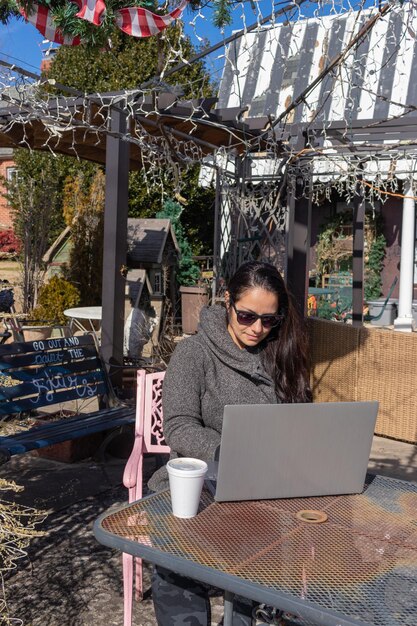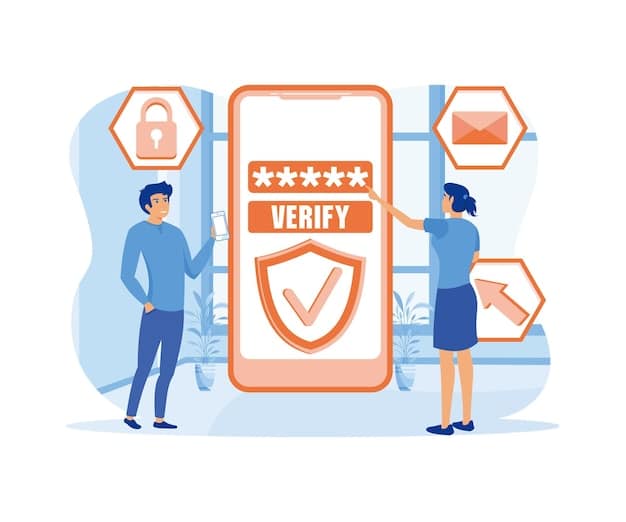Digital Nomad Security: 5 Steps to Protect Your Data in the US (2025)

Digital nomad security is paramount when traveling the US in 2025; these five essential steps—utilizing VPNs, enabling two-factor authentication, securing devices, managing public Wi-Fi risks, and regularly backing up data—are crucial for safeguarding personal and professional information against cyber threats.
As a digital nomad exploring the US in 2025, your laptop isn’t just a tool—it’s your office, your lifeline, and a treasure trove of personal information. Ensuring digital nomad security: 5 essential steps to protect your data while traveling the US in 2025 is essential. With increasing cyber threats, it’s crucial to fortify your defenses to safeguard your sensitive information and maintain peace of mind.
Understanding the Unique Security Risks for Digital Nomads in the US
The allure of the digital nomad lifestyle in the US—from the bustling streets of New York to the serene landscapes of Montana—is undeniably attractive. However, this freedom comes with unique security challenges. Unlike traditional office environments, digital nomads often rely on public Wi-Fi and may face increased risks of device theft or exposure to sophisticated cyber threats.
Before diving into the practical steps, it’s important to understand the landscape of potential threats that digital nomads may encounter while traveling the US.
Why are Digital Nomads Prime Targets?
Digital nomads are particularly vulnerable due to several factors. First, the use of public Wi-Fi in cafes, hotels, and coworking spaces puts your data at risk of interception by hackers. These networks often lack adequate security measures, making it easier for malicious actors to steal your personal information.
Second, the transient nature of the lifestyle means that devices are more likely to be lost or stolen. A single lost or stolen laptop can expose a wealth of sensitive data, including personal emails, financial information, and client data.
Common Security Threats
Here are some common security challenges digital nomads face:
- Phishing Attacks: Cybercriminals use deceptive emails or websites to trick you into revealing sensitive information.
- Malware Infections: Downloading infected files or clicking on malicious links can compromise your device.
- Unsecured Public Wi-Fi: Connecting to public Wi-Fi without protection exposes your data to interception.
- Physical Theft: Laptops, smartphones, and other devices can be stolen from cafes, hotels, or even your vehicle.
Understanding these unique risks is the first step toward implementing effective security measures. By taking proactive steps to protect your data, you can enjoy the freedom of the digital nomad lifestyle without compromising your security.

In conclusion, as a digital nomad in the US, recognizing these unique security risks is vital. By understanding the challenges and taking proactive steps, you can mitigate potential threats and enjoy a safer, more secure digital nomad experience.
Step 1: Utilize a Virtual Private Network (VPN)
A Virtual Private Network (VPN) is arguably the single most important tool in a digital nomad’s security arsenal. Think of it as a secure tunnel that encrypts your internet traffic, protecting it from prying eyes. Whether you’re working from a coffee shop in Seattle or a library in Chicago, a VPN helps ensure your data remains private and secure.
Implementing a VPN can feel daunting, but it’s a simple process that offers substantial protection.
How a VPN Protects Your Data
A VPN creates an encrypted connection between your device and a remote server operated by the VPN provider. All your internet traffic is routed through this secure tunnel, making it virtually impossible for hackers to intercept your data, such as passwords, emails, and browsing history.
Moreover, a VPN masks your IP address, making it harder for websites and advertisers to track your online activities. This added layer of anonymity can provide a significant boost to your overall online privacy.
Choosing the Right VPN
With numerous VPN providers available, it’s essential to choose one that meets your specific needs. Here are a few factors to consider:
- Security Protocols: Look for VPNs that use strong encryption protocols, such as OpenVPN or WireGuard.
- No-Logs Policy: Choose a VPN provider that has a strict no-logs policy, meaning they don’t track or store your online activities.
- Server Locations: Opt for a VPN with servers located in multiple countries, allowing you to bypass geo-restrictions and access content from around the world.
- Speed and Reliability: Read reviews and test different VPNs to find one that offers fast and reliable connections.
Popular VPN services include NordVPN, ExpressVPN, and Surfshark. All three offer robust security features and user-friendly interfaces.
By consistently using a VPN, you can protect your sensitive information and browse the internet with peace of mind. It’s a small investment that offers significant security benefits, making it an indispensable tool for every digital nomad.
Step 2: Enable Two-Factor Authentication (2FA) on All Accounts
In the digital age, passwords alone are often not enough to protect your online accounts. Two-Factor Authentication (2FA) provides an extra layer of security by requiring a second form of verification in addition to your password. Enabling 2FA on all your accounts is a crucial step in securing your digital life as a nomad.
The principles behind 2FA are simple, yet highly effective in keeping your accounts safe from unauthorized access.
Why 2FA is Essential
Even with a strong and unique password, your account can still be compromised through phishing attacks or data breaches. 2FA mitigates this risk by requiring a second verification method, such as a code sent to your smartphone or generated by an authenticator app.
This means that even if a hacker manages to obtain your password, they still won’t be able to access your account without the second verification factor.
How to Enable 2FA
Most major online services, including Google, Microsoft, social media platforms, and financial institutions, offer 2FA options. The process for enabling 2FA typically involves the following steps:
- Log in to your account settings.
- Look for the “Security” or “Privacy” section.
- Find the “Two-Factor Authentication” or “Two-Step Verification” option.
- Choose your preferred verification method, such as SMS codes, authenticator apps (like Google Authenticator or Authy), or hardware security keys.
Once enabled, you’ll need to enter the second verification code each time you log in from a new device or location. While this may add a few extra seconds to the login process, the added security is well worth the effort.
By enabling 2FA on all your important accounts, you create a formidable barrier against unauthorized access. It’s a simple yet powerful step that significantly enhances your digital security.

Step 3: Secure Your Devices
Your devices—laptops, smartphones, and tablets—are your lifeline as a digital nomad. Securing these devices is paramount to protecting your data and preventing unauthorized access. There are several proactive steps you can take to ensure your devices are properly protected, regardless of where your travels take you.
The security measures you implement should be comprehensive and regularly updated to address evolving threats.
Essential Security Measures for Your Devices
Here are some key steps to secure your devices effectively:
- Use Strong Passwords or Biometrics: Ensure your devices are protected with strong, unique passwords or biometric authentication, such as fingerprint or facial recognition.
- Enable Device Encryption: Encrypt your device’s storage to protect your data even if it’s lost or stolen. Modern operating systems like Windows, macOS, Android, and iOS offer built-in encryption features.
- Install Antivirus Software: Protect your devices from malware and viruses by installing reputable antivirus software and keeping it up to date.
- Keep Your Software Updated: Regularly update your operating system and applications to patch security vulnerabilities.
Additional Security Precautions
Beyond these fundamental measures, consider these additional precautions:
- Install a Remote Wipe App: In case of theft, a remote wipe app allows you to erase your device’s data remotely, preventing unauthorized access to your sensitive information.
- Use a Physical Security Lock: When working in public spaces, use a physical security lock to secure your laptop to a table or other fixed object.
- Be Mindful of Your Surroundings: Be aware of your surroundings and avoid leaving your devices unattended in public places.
Securing your devices is a multi-faceted approach that requires vigilance and proactive measures. By implementing these steps, you can significantly reduce the risk of device theft or compromise, and protect your valuable data.
Step 4: Manage the Risks of Public Wi-Fi
Public Wi-Fi is a convenient and readily available resource for digital nomads, but it also poses significant security risks. These networks are often unsecured, making them vulnerable to hacking and data interception. Managing the risks of public Wi-Fi is crucial for maintaining your digital security while traveling.
Understanding the inherent dangers of public Wi-Fi is the first step in mitigating those risks.
The Dangers of Public Wi-Fi
Public Wi-Fi networks are often unsecured, meaning that your data can be intercepted by hackers using readily available tools. This is especially true for networks that don’t require a password or use weak encryption protocols.
When you connect to an unsecured public Wi-Fi network, your data—including passwords, emails, and browsing history—can be vulnerable to interception by malicious actors.
Strategies for Using Public Wi-Fi Safely
Here are some strategies for using public Wi-Fi safely:
- Use a VPN: As mentioned earlier, a VPN encrypts your internet traffic, protecting it from interception on public Wi-Fi networks.
- Enable a Firewall: Firewalls provide a barrier between your device and the internet, blocking unauthorized access and preventing malware infections.
- Avoid Sensitive Transactions: Refrain from conducting sensitive transactions, such as online banking or shopping, on public Wi-Fi networks.
Verify Network Legitimacy
Always verify the legitimacy of the Wi-Fi network before connecting. Hackers sometimes set up fake Wi-Fi hotspots that mimic legitimate networks. Confirm the network name with the establishment to ensure you’re connecting to the correct network.
By implementing these strategies, you can significantly reduce the risks associated with using public Wi-Fi and protect your data from interception. It’s about being cautious and taking the necessary precautions to safeguard your online activities.
Step 5: Regularly Back Up Your Data
Data loss can be a devastating experience for anyone, but it can be particularly disruptive for digital nomads who rely on their devices for work and communication. Regularly backing up your data is an essential step in mitigating the impact of data loss, whether it’s caused by device theft, hardware failure, or malware infection.
Establishing a consistent backup routine ensures that your critical files and documents are safe and recoverable.
Backup Options for Digital Nomads
There are several backup options available for digital nomads, each with its own advantages and disadvantages:
- Cloud Storage: Cloud storage services like Google Drive, Dropbox, and OneDrive offer automatic backups and allow you to access your data from anywhere with an internet connection.
- External Hard Drives: External hard drives provide a secure and portable backup solution. Regularly connect your device to the external hard drive to create backups.
- Network-Attached Storage (NAS): A NAS device is a dedicated storage server that connects to your home or office network. It provides a centralized backup solution for multiple devices.
Best Practices for Data Backup
Here are some best practices for data backup:
- Automate Your Backups: Set up automatic backups to ensure your data is regularly backed up without requiring manual intervention.
- Use Multiple Backup Locations: Consider using a combination of cloud storage and external hard drives for redundancy.
- Test Your Backups: Regularly test your backups to ensure they are working properly and that you can restore your data when needed.
By regularly backing up your data and following these best practices, you can minimize the impact of data loss and quickly recover your files in the event of a disaster. It’s a simple yet crucial step in protecting your digital life.
| Key Point | Brief Description |
|---|---|
| 🔒 Use VPN | Encrypt internet traffic for secure connections. |
| 🔑 Enable 2FA | Add an extra layer of security to online accounts. |
| 🛡️ Secure Devices | Use strong passwords, enable encryption, and install antivirus. |
| 📡 Manage Wi-Fi | Use VPN on public Wi-Fi, verify network legitimacy. |
Frequently Asked Questions
▼
A VPN encrypts your internet traffic, protecting it from interception on public Wi-Fi networks, and masks your IP address, providing an added layer of anonymity.
▼
2FA requires a second form of verification in addition to your password, making it much harder for hackers to access your accounts, even if they have your password.
▼
Immediately use a remote wipe app to erase your device’s data, change your passwords for all important accounts, and report the theft to the authorities.
▼
Ideally, you should back up your data daily or at least weekly. Automate your backups to ensure they are done regularly without manual intervention.
▼
Popular antivirus software options include Norton, McAfee, and Bitdefender. Choose a reputable antivirus program and keep it updated to protect against malware.
Conclusion
Securing your digital life as a nomad in the US doesn’t have to be daunting. By implementing these five essential steps—utilizing VPNs, enabling two-factor authentication, securing your devices, managing public Wi-Fi risks, and regularly backing up your data—you can significantly reduce your risk of cyber threats and enjoy the freedom of remote work with peace of mind. Stay vigilant, stay secure, and embrace the digital nomad lifestyle to its fullest.





